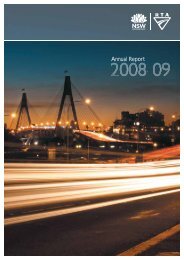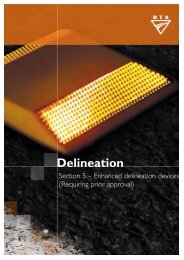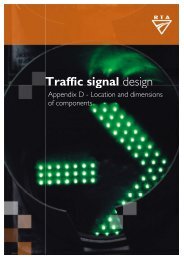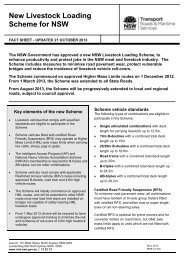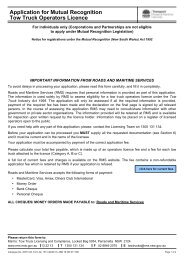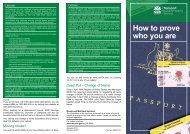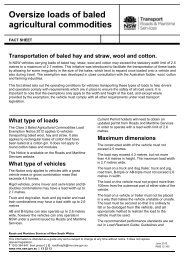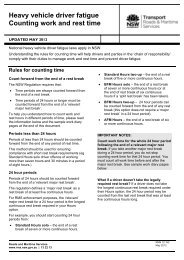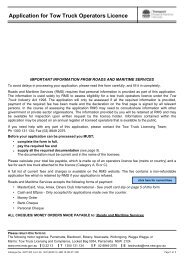Traffic Signal Design - Section 11 Detectors - RTA
Traffic Signal Design - Section 11 Detectors - RTA
Traffic Signal Design - Section 11 Detectors - RTA
You also want an ePaper? Increase the reach of your titles
YUMPU automatically turns print PDFs into web optimized ePapers that Google loves.
<strong>Traffic</strong> <strong>Signal</strong> <strong>Design</strong> – <strong>Section</strong> <strong>11</strong> <strong>Detectors</strong><br />
of-way so that the green signal can be extended depending on the prevailing traffic conditions<br />
(i.e. extends a phase).<br />
Detector logic is used to specify the conditions under which an actuation from a detector can<br />
call or extend a phase. For example, the standard detector logic for a stop-line detector is:<br />
• demand a phase except while it is green<br />
• extend a phase while it is green<br />
In the above logic, there is only one phase involved and only one condition for each function.<br />
This amount of logic is sufficient for a simple two-phase design, but for most other types of<br />
phasing, several conditions may be required and a detector may demand and/or extend more<br />
than one phase. When designing detector logic for these situations, the basic aim is to<br />
minimise the cycle time while satisfying all the traffic and safety needs of the intersection. This<br />
is achieved by:<br />
• avoiding the introduction of unnecessary phases by only registering and maintaining<br />
demands which are actually required<br />
• demanding a phase that satisfies the most (or main) vehicle movements<br />
• minimising the variable initial green time by only allowing detectors to increment<br />
when a queue is forming<br />
• avoiding unnecessary extension of a phase, e.g. by ceasing extension by vehicles on a<br />
given movement when that movement also runs in the following phase<br />
The detector logic should be designed to operate in conjunction with SCATS regardless of<br />
whether or not SCATS is in use. Most importantly, the logic should attempt to provide the<br />
most efficient operation regardless of the phase sequence. Detector logic may require<br />
complex operation and it is imperative that the detector logic is expressed correctly in the<br />
manner described in drawing No. TS-TN-020. This facilitates the preparation of the controller<br />
personality.<br />
A detector specification schedule must be included on all design plans except for two-phase<br />
designs and standard diamond overlaps (see TS-TN-026 and TS-TN-027).<br />
The principles of detector logic, standard detector functions, the symbolic method used to<br />
prepare a detector specification schedule and examples are provided in drawing No. TS-TN-<br />
020. This includes detector logic for the normal push-button calling functions.<br />
<strong>11</strong>.7.2 Independently-timed marked footcrossings<br />
Generally two parallel and functionally identical marked foot crossings operate independently<br />
of one another so that each displays a walk signal only when demanded. This allows for<br />
separate lamp monitoring of each crossing and avoids unnecessarily delaying vehicle<br />
movements e.g. when the crossings are different lengths or when pedestrian protection is<br />
provided.<br />
The push-button detectors are given a numeric suffix the same as the associated pedestrian<br />
lantern to identify them as being independent and each detector is given a separate entry in the<br />
detector specification schedule as shown in Table <strong>11</strong>.2.<br />
<strong>11</strong>-10 Version 1.3<br />
UNCONTROLLED WHEN PRINTED



